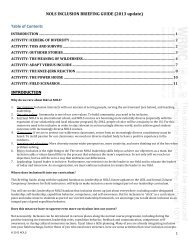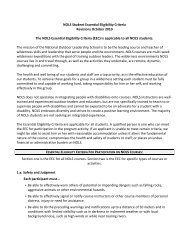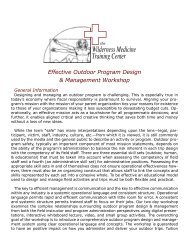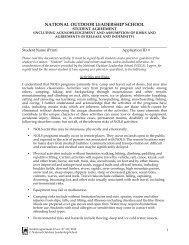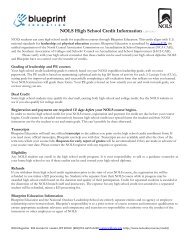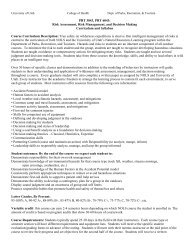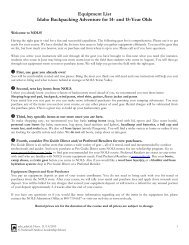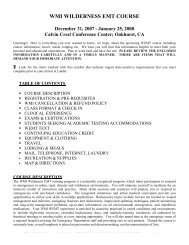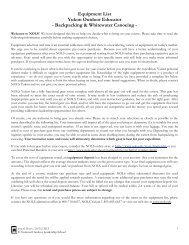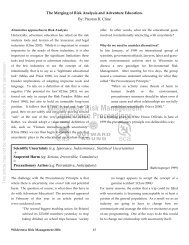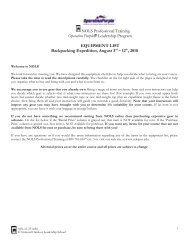CoachingConsider how best <strong>to</strong> coach your students. Everyone has <strong>the</strong>irown style. Will you wait <strong>to</strong> give feedback until <strong>the</strong> end of <strong>the</strong> day?How much should you interject while <strong>the</strong>y lead? How you coachyour students provides lessons just as valuable as <strong>the</strong> actual coachingyou offer. You don’t need <strong>to</strong> discuss <strong>the</strong> educational merits of yourcoaching; it’s enough that you model respectful habits. Much of acourse’s experience speaks for itself and doesn’t need <strong>to</strong> be reduced<strong>to</strong> words <strong>to</strong> be educational. Let your coaching be an example of oneway <strong>to</strong> teach experientially.Teachable MomentsAs instruc<strong>to</strong>rs become more fluent with <strong>the</strong> curriculum <strong>the</strong>y alsobecome more adept at finding natural teaching opportunities on anexpedition. Wea<strong>the</strong>r moves in, Plan A gets <strong>to</strong>ssed out <strong>the</strong> window,and <strong>the</strong> savvy instruc<strong>to</strong>r finds a minute <strong>to</strong> mention <strong>to</strong>lerance foradversity. There is almost always a <strong>leadership</strong> lesson hidden in <strong>the</strong>day’s events. It isn’t luck, it’s seeing <strong>the</strong> opportunities in change. Inthis example, if it was your course and you had just decided <strong>to</strong> backoff of a sea kayak paddle around a point, <strong>the</strong> discussion afterwardwould be <strong>the</strong> perfect opportunity <strong>to</strong> teach about situational <strong>leadership</strong>and decision-making in a set of circumstances that may nothave been relevant yet on your expedition.NOLS expeditions must be challenging enough that leaders,both student and instruc<strong>to</strong>r, practice dealing with dynamic systemsand applying <strong>the</strong>ir knowledge <strong>to</strong> new situations. Some <strong>leadership</strong>schools intentionally create conditions where leaders-in-trainingneed <strong>to</strong> make timely decisions with incomplete information. Onour expeditions <strong>the</strong>se situations literally come with <strong>the</strong> terri<strong>to</strong>ry.Our job is <strong>to</strong> finesse <strong>the</strong>se events, balancing student decision-makingopportunities with sound risk management practices.In stressful conditions, if a student leader doesn’t default <strong>to</strong> an appropriate<strong>leadership</strong> style, <strong>the</strong>n instruc<strong>to</strong>rs can recommend a quickand efficient approach. Once <strong>the</strong> LOD has made and implementeda plan, it is <strong>the</strong> perfect time <strong>to</strong> discuss it as part of <strong>the</strong> <strong>leadership</strong> curriculum—asclose as possible <strong>to</strong> still being “in <strong>the</strong> moment.” Later atcamp might be a good time <strong>to</strong> discuss <strong>the</strong> <strong>the</strong>oretical pros and consof different ways <strong>to</strong> make decisions in similar, future situations.Everything depends on how well <strong>the</strong> student leader is handling<strong>the</strong> situation and on how much <strong>the</strong> group can afford <strong>to</strong> flounder.Our aim is <strong>to</strong> prepare our students <strong>to</strong> succeed in critical situationsby <strong>the</strong>mselves.Integral EducationIt can take a new instruc<strong>to</strong>r dozens of field weeks of apprenticing<strong>to</strong> competently teach single <strong>leadership</strong> <strong>to</strong>pics, let alone meld <strong>the</strong>min<strong>to</strong> a fluid progression.Senior instruc<strong>to</strong>rs can help junior instruc<strong>to</strong>rs by modeling greatteaching and effective decision-making, and by coaching in appropriatedoses.Stress and Peak PerformanceStudents who are stressed cannot perform at <strong>the</strong>ir peak. Stressmay come from environmental fac<strong>to</strong>rs or from within <strong>the</strong> students’own minds as <strong>the</strong>y work <strong>to</strong> learn <strong>the</strong> course material. Students alsofeel stress when <strong>the</strong>y do not feel safe in <strong>the</strong> group <strong>the</strong>y are part of.Chronic stress impairs a student’s ability <strong>to</strong> sort out what’s importantand what’s not (Jensen, 1988). (Read more about this in <strong>the</strong>NOLS Wilderness Educa<strong>to</strong>r Notebook.) While we cannot change<strong>the</strong> environmental fac<strong>to</strong>rs we encounter, we can help groups reducesocial stresses.Hormones such as cortisol are commonly released during periodsof stress and sero<strong>to</strong>nin levels are affected, as well. Diminished sero<strong>to</strong>ninlevels have been linked <strong>to</strong> violent and aggressive behaviors.For example, students who are “<strong>to</strong>p dog” in <strong>the</strong>ir home life andjust “one of many” in a classroom might become more impulsive(Jensen, 1998). Some of <strong>the</strong>se students flourish when given roleslike LOD. Studies suggest that classroom status or social hierarchieschange <strong>the</strong> brain’s chemistry. This makes a good case for <strong>the</strong> importanceof changing roles often <strong>to</strong> ensure everyone has a chance <strong>to</strong> leadand follow.It is imperative that we maintain a safe and positive learning environmentso our students can reach <strong>the</strong>ir full potential. We mustallow each student <strong>to</strong> find a place in <strong>the</strong> group that <strong>the</strong>y are comfortablewith relative <strong>to</strong> <strong>the</strong> o<strong>the</strong>r students. We must also allow each ofour students <strong>to</strong> be pushed in a healthy manner so <strong>the</strong>y realize <strong>the</strong>yare capable of more than <strong>the</strong>y expected.A SAMPLE COURSELEADERSHIP PROGRESSIONPHASE I—Setting GroundworkStudent focus—establish group goals, values, and expectations.Instruc<strong>to</strong>r focus—provide direction, expectations, and a safe environment.Role model expected behaviors.First Few Field Days• Outline <strong>the</strong> seven <strong>leadership</strong> skills. Talk about what <strong>the</strong>y looklike on this course. Involve <strong>the</strong> students.• Go over evaluations and expectations in detail.• Explain <strong>the</strong> <strong>leadership</strong> and course progressions. Diagram this viaa pyramid or a ladder. Explain what you as instruc<strong>to</strong>rs will be doing.Explain when and how students can influence <strong>the</strong> progression.If traveling on <strong>the</strong>ir own is part of <strong>the</strong> progression, explaincriteria required for <strong>the</strong> students <strong>to</strong> be allowed <strong>to</strong> do this.• Model leading. Make decisions in front of students. Questionand clarify in front of <strong>the</strong> whole group.• Give a short, simple decision-making class, Part One (see “Decision-Making,”4-4).• Debrief your own leading each day with <strong>the</strong> student group. Giveinstruc<strong>to</strong>rs feedback publicly. Admit mistakes, say what youlearned, and move on. Tell o<strong>the</strong>rs what you did well and what<strong>the</strong>y did well.• Start teaching classes that students will need <strong>to</strong> lead (such as“Travel Plans”.• Allow people time <strong>to</strong> get <strong>to</strong> know each o<strong>the</strong>r. Do many fun activities.Goals for Phase I:• Discuss Positive Learning Environment/Expedition Behavior.• Agree on group goals and values.• Introduce <strong>the</strong> seven NOLS Leadership Skills.• Model <strong>leadership</strong>.• Clarify course structure and expectations.• Review evaluation and feedback process.• Teach a simple decision-making class.• Have fun as a whole group.Introduction 6<strong>2008</strong> NOLS Leadership Educa<strong>to</strong>r Notebook
• Introduce some of <strong>the</strong> skills students need <strong>to</strong> lead in this environment(travel plans, etc.)• Help students see how past experiences will help <strong>the</strong>m on thiscourse (transference).Day 1• Get yourself and your students jazzed. Explain overall coursegoals, <strong>the</strong> big picture.• Involve students in organizing for <strong>the</strong> expedition wherever possible.• Do something fun <strong>to</strong>ge<strong>the</strong>r such as an icebreaker.• Put your students at ease by explaining or discussing <strong>the</strong> role ofstudents and instruc<strong>to</strong>rs—knowing what is expected of <strong>the</strong>m canhelp your students <strong>to</strong> succeed as well as relax.Day 2• Explain <strong>the</strong> concept of Expedition Behavior. Facilitate a discussionof what makes a great group and a positive learning environment(see “Positive Learning Environment,” 2-1).• Introduce <strong>the</strong> seven NOLS Leadership Skills and tie <strong>the</strong>m in<strong>to</strong>this talk.• Have <strong>the</strong> group come up with two <strong>to</strong> four group goals <strong>the</strong>y want<strong>to</strong> strive for which are separate from instruc<strong>to</strong>r expectations—<strong>the</strong>students make and own <strong>the</strong>se.• Have everyone sign <strong>the</strong> positive learning environment goals.PHASE II—Learning LeadershipStudent focus—learn <strong>leadership</strong> roles, responsibilities, and expectations.Practice leading. Have fun.Instruc<strong>to</strong>r focus—set <strong>leadership</strong> expectations. Reinforce, correct,and coach students on <strong>the</strong>ir <strong>leadership</strong>.Started Before The End Of The First Week• Facilitate a short discussion on what everyone believes is “good<strong>leadership</strong>.”• Describe <strong>the</strong> role, responsibilities and expectations of <strong>the</strong> LOD(see article on “Leader of <strong>the</strong> Day”). Discuss <strong>the</strong> role of <strong>the</strong> instruc<strong>to</strong>rwhen a student is leading. Re-negotiate this with eachstudent or team every time <strong>the</strong>y lead.• Observe and coach students as <strong>the</strong>y lead.• Teach a communication skills class and lead a group activity (see“Communication Class” outline, 5-1).• Debrief student LODs every day using a structure <strong>the</strong>y will laterbe able <strong>to</strong> use <strong>the</strong>mselves (see article on “Student Debriefs,”7-1). Short <strong>leadership</strong> <strong>the</strong>ory nuggets impromptu well in <strong>the</strong>sedebriefs.• Check in with your student groups. This need not take long, butshould occur frequently. Ask, “What more do you need from us?What is helpful that we are doing?” And listen!• As soon as <strong>the</strong> first few niggles (slight discomforts) show up in<strong>the</strong> group, talk about <strong>the</strong> stages of group development (see articleon “Group Development,” 2-3).• Give an in-depth decision-making class once <strong>the</strong>y’ve practiced abit (see “Decision-Making,” 4-4).• Conduct a <strong>leadership</strong> styles exercise or discussion.Goals for Phase II:• Teach a Leader Of <strong>the</strong> Day class.• Give each student a chance <strong>to</strong> lead at least once, ei<strong>the</strong>r as part ofa team or individually.• Teach a decision-making class.• Students start using modeled debrief formats.• Lead at least one <strong>leadership</strong> styles discussion or exercise.• Check in one-on-one with each student.• Conduct several group check-ins.• Lead a communication skills class/exercise.• Introduce <strong>the</strong> stages of group development.• Ask students <strong>to</strong> discuss how <strong>the</strong> skills <strong>the</strong>y are learning are applicable<strong>to</strong> non-NOLS course situations (transference).PHASE III—Developing LeadershipStudent focus—Practice skills. Coach <strong>the</strong>ir peers. Meet increasingchallenges, continue <strong>to</strong> have fun and learn new skills.Instruc<strong>to</strong>r focus—Transition <strong>to</strong> shadow-coaching and consulting.Middle Section of Course• Facilitate first tent group debriefs. Typically, second and thirdtent group debriefs are run by <strong>the</strong> students.• Teach more <strong>leadership</strong> classes.• When you notice conflict brewing, do a conflict managementexercise (see “Conflict,” 2-6), <strong>the</strong>n have <strong>the</strong> students manage it.• Conduct <strong>the</strong> “No-Doze Leadership” exercise (see 7-2).• Before students are allowed <strong>to</strong> plan a ration period, teach a classon decision-making in large groups (see “Group Meetings” article,11-4).• In debriefs, link your role as an instruc<strong>to</strong>r <strong>to</strong> a larger framework—reference classes, patterns of good and bad behavior that you haveobserved on <strong>the</strong> course, <strong>the</strong>ories, s<strong>to</strong>ries and o<strong>the</strong>r skills.• Students can teach o<strong>the</strong>r <strong>leadership</strong> classes of <strong>the</strong>ir interest, e. g.“Gender-Specific Leadership Styles.” Consider having <strong>the</strong>m reteacha skill for practice.• Provide mid-course evaluations. Ask students <strong>to</strong> come prepared<strong>to</strong> discuss how <strong>the</strong>y are doing on <strong>the</strong> seven <strong>leadership</strong> skills andhow <strong>the</strong>y intend <strong>to</strong> make progress. Ask <strong>the</strong>m <strong>to</strong> give you feedbackas well.• Revisit group goals and values. If <strong>the</strong> group is progressing well,consider letting <strong>the</strong>m plan and implement new goals and changesafter you approve <strong>the</strong>m. If <strong>the</strong> group is not meeting expectations,your instruc<strong>to</strong>r team needs <strong>to</strong> be more active in meetings. Make<strong>the</strong> group aware of gaps, explaining what you want <strong>the</strong> group <strong>to</strong>do and why.By <strong>the</strong> end of Phase III, all students will have had at least twomore opportunities <strong>to</strong> lead o<strong>the</strong>rs individually or as part of a team.They have evaluated <strong>the</strong>ir <strong>leadership</strong>.PHASE IV—Transitioning To IndependenceStudent focus—Practice, practice, practice! Encounter challengingsituations. Have fun. Learn limitations.Instruc<strong>to</strong>r focus—Moni<strong>to</strong>r, step back, and transition.• Continue with classes, debriefs, and activities—check <strong>to</strong> see thatstudents have all <strong>the</strong> basic skills down.• In Phase III or IV, student teams may start planning and facilitatingmulti-day curriculum and travel. Groups may plan a rationperiod, organize a service project, simulate a rescue, etc.• If appropriate, students may lead and travel without instruc<strong>to</strong>rsin phase III or IV. Check in and debrief as appropriate. If youdo not allow students <strong>to</strong> lead in <strong>the</strong> absence of instruc<strong>to</strong>rs, o<strong>the</strong>roptions are shadowing <strong>the</strong> groups, small groups with instruc<strong>to</strong>rs,etc. (see “Independent Small Group Expeditions” article).<strong>2008</strong> NOLS Leadership Educa<strong>to</strong>r Notebook 7Introduction




